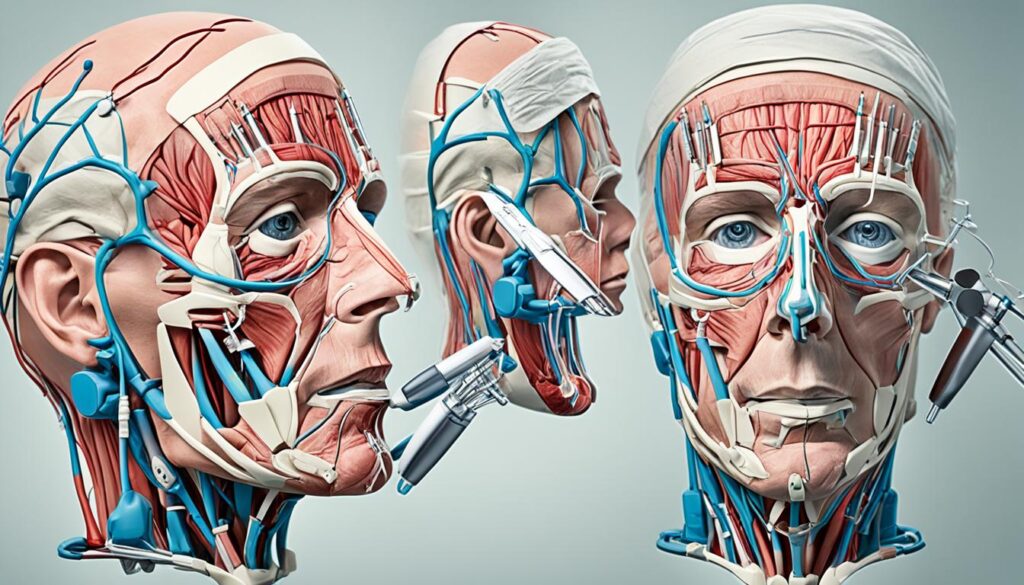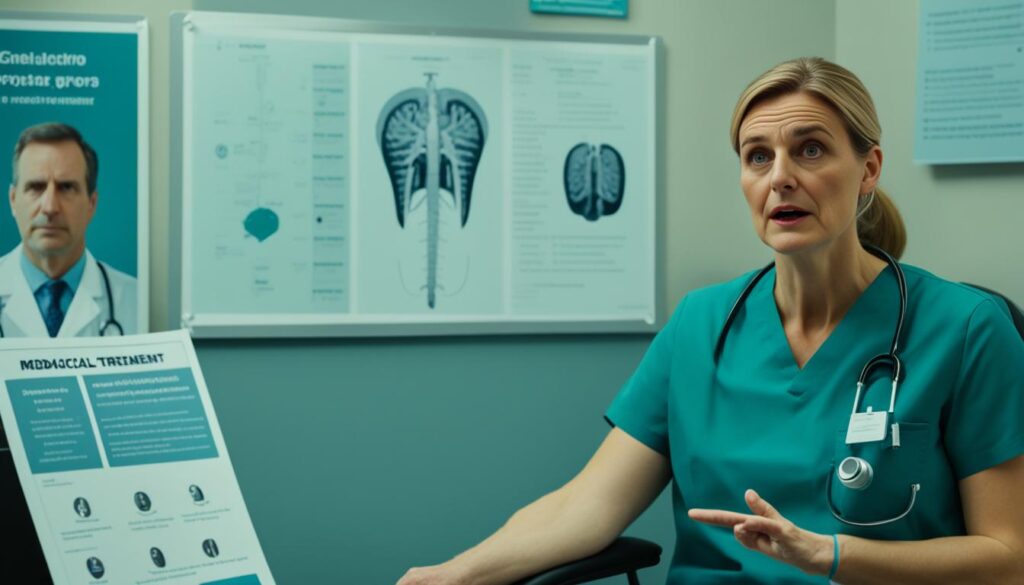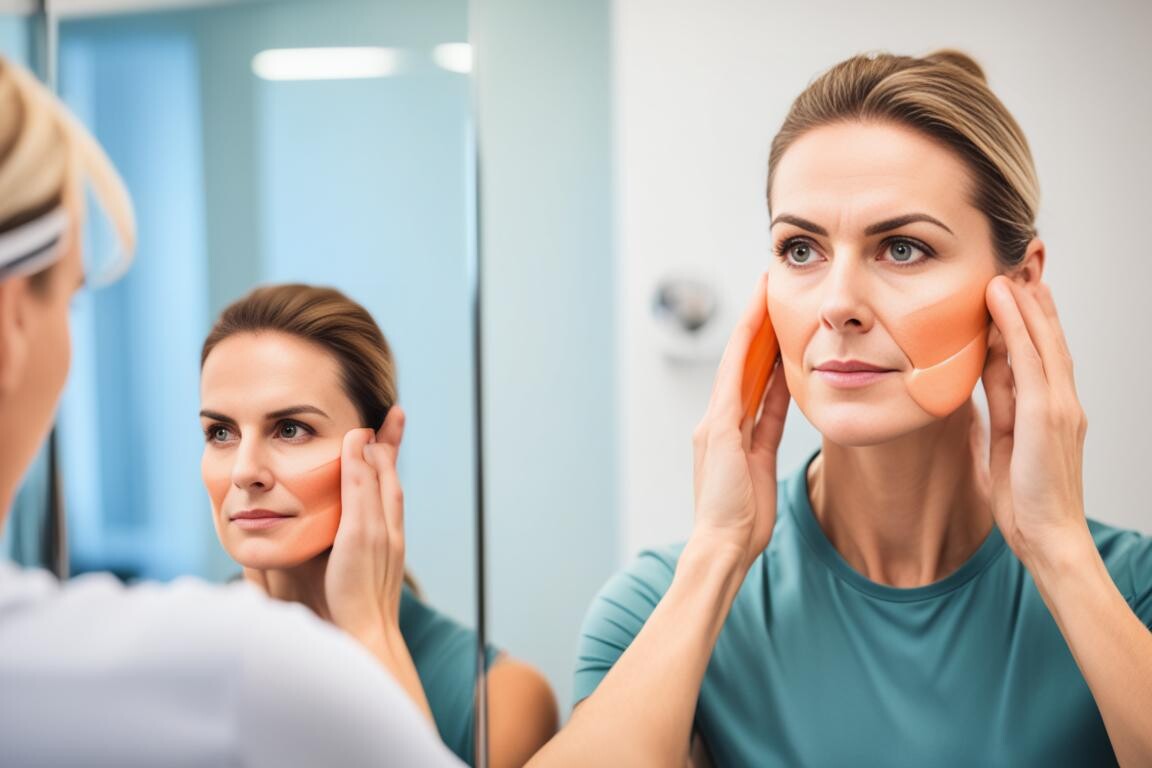Facial nerve paralysis can be a challenging condition to treat. However, there are effective treatment options available that can help restore facial symmetry and improve facial function. In this article, we will explore the different treatment options for facial nerve paralysis and discuss their effectiveness in restoring facial movement and improving quality of life.
Key Takeaways:
- Facial nerve paralysis can be effectively treated with various treatment options.
- Treatment choice depends on the duration and severity of the paralysis.
- Surgical options include facial nerve decompression, nerve transfer procedures, and muscle transfers.
- Non-surgical options such as acupuncture and biofeedback training can also be beneficial.
- Collaborating closely with healthcare professionals is crucial for finding the most suitable treatment approach.
Table of Contents
ToggleDiagnosing Facial Nerve Paralysis
Diagnosing facial nerve paralysis involves a comprehensive evaluation of your symptoms and a physical examination by a healthcare professional. This process allows doctors to determine the severity of the nerve damage and rule out other potential causes. In some cases, additional tests may be recommended to provide a more accurate diagnosis.
Physical Examination
During the physical examination, your doctor will assess your facial muscles, movement, and symmetry. They will carefully observe your ability to make facial expressions, close and open your eyes, and move your lips. Additionally, they may test your ability to taste, as the facial nerve also contributes to taste sensation in the front two-thirds of the tongue.
Specific Tests
To further evaluate facial nerve paralysis, your doctor may recommend specific tests to confirm the diagnosis and assess the extent of nerve damage. These tests include:
- Electromyography (EMG): This test measures the electrical activity of your facial muscles. It involves the insertion of small needles into the muscles to evaluate their function and response to nerve signals.
- Imaging Scans: Magnetic resonance imaging (MRI) and computerized tomography (CT) scans may be performed to visualize the facial nerve and rule out other possible causes of paralysis, such as tumors or structural abnormalities.
- Blood Tests: Blood tests can be used to rule out infections, autoimmune disorders, or other underlying medical conditions that could contribute to facial nerve paralysis.
These diagnostic tests help your healthcare team determine the most appropriate treatment plan for your specific condition.

| Diagnostic Tests | Purpose |
|---|---|
| Electromyography (EMG) | To measure the electrical activity of facial muscles and assess nerve function. |
| Imaging Scans (MRI/CT) | To visualize the facial nerve and rule out other potential causes of paralysis. |
| Blood Tests | To rule out infections and underlying medical conditions. |
Treating Acute Facial Paralysis
Acute facial paralysis refers to a temporary loss of facial muscle function that lasts for less than three weeks. When faced with this condition, surgical treatment options can be employed to help alleviate symptoms and restore facial movement. Two common surgical procedures used for the treatment of acute facial paralysis are facial nerve decompression and facial nerve repair.
Facial Nerve Decompression
Facial nerve decompression is a surgical procedure aimed at relieving pressure on the facial nerve. This pressure is often caused by viral infections such as Bell’s palsy. By relieving the pressure, the surgical intervention can help restore facial function and hasten the recovery process.

Facial Nerve Repair
In cases where the facial paralysis is caused by direct nerve damage, facial nerve repair may be necessary. This surgery involves repairing or grafting the damaged facial nerve, allowing for the restoration of proper nerve function. Facial nerve repair can greatly improve facial movement and enhance overall recovery.
By opting for appropriate surgical interventions such as facial nerve decompression or facial nerve repair, individuals experiencing acute facial paralysis can benefit from improved facial function and a faster and more complete recovery process.
Managing Intermediate Duration Facial Paralysis
When faced with intermediate duration facial paralysis, lasting between three weeks and two years, nerve transfer procedures offer an effective treatment option. These procedures involve transferring nerves from unaffected areas of the body to the paralyzed facial muscles, such as the hypoglossal nerve, spinal accessory nerve, or branches of the trigeminal nerve. By restoring movement and function to the affected side of the face, nerve transfer procedures are instrumental in managing intermediate duration facial paralysis.
How Nerve Transfer Procedures Work
Nerve transfer procedures entail surgically connecting healthy nerves to the damaged facial nerves. This connection allows the healthy nerves to take over the function of the paralyzed facial muscles, facilitating improved facial movement and symmetry. By utilizing nerves from different areas of the body, nerve transfer procedures present a viable solution for managing intermediate duration facial paralysis.
During the surgery, the surgeon carefully selects the appropriate nerves to facilitate optimal facial function. The choice of nerve depends on factors such as the specific muscles affected and the severity of the paralysis. By strategically transferring nerves, the surgeon aims to restore movement and achieve the desired aesthetic outcome.
Post-surgery, patients undergo personalized rehabilitation to stimulate the newly transferred nerves and promote muscle reeducation. Through exercises and targeted therapies, individuals can enhance their facial control and regain natural movement.
The Benefits of Nerve Transfer Procedures
- Restoration of facial movement: By transferring nerves to the paralyzed facial muscles, nerve transfer procedures enable the restoration of facial movement, improving both functionality and expression.
- Enhanced facial symmetry: Nerve transfer procedures also contribute to improved facial symmetry, addressing the imbalances caused by the paralysis.
- Improved quality of life: The restoration of facial movement and symmetry can significantly enhance an individual’s quality of life, boosting their confidence and self-esteem.
Nerve transfer procedures are a valuable treatment option for managing intermediate duration facial paralysis. These surgeries offer the potential for significant improvement in facial movement, symmetry, and overall well-being.

Image: Illustration depicting the management of intermediate duration facial paralysis.
Reconstructive Surgery for Chronic Facial Paralysis
In cases of chronic facial paralysis that lasts longer than two years, reconstructive surgery is often required. Reconstructive surgery aims to restore facial symmetry and improve facial function, allowing individuals to regain their confidence and quality of life.
The Techniques Used
There are two common techniques employed in reconstructive surgery for chronic facial paralysis: regional muscle transfer and free muscle transfer.
Regional muscle transfer involves moving a muscle from a nearby area to the paralyzed side of the face to restore movement. One example of regional muscle transfer is the temporalis muscle transfer, where the muscle from the temple area is used to replace the paralyzed facial muscles. This technique allows for the restoration of natural facial movements by utilizing the adjacent muscle’s strength.
Free muscle transfer takes a different approach by using a muscle from another part of the body to replace the paralyzed facial muscles. The chosen muscle is detached at its origin and transferred to the face, providing new functionality and movement. Free muscle transfer is typically reserved for complex cases or when regional muscle transfer is not feasible.
Both regional muscle transfer and free muscle transfer have shown promising results in improving facial symmetry and function for individuals with chronic facial paralysis.
Benefits of Reconstructive Surgery
Reconstructive surgery for chronic facial paralysis offers several benefits, including:
- Improved facial symmetry
- Restoration of facial movement
- Enhanced quality of life
By addressing the root cause of the paralysis and utilizing muscle transfer techniques, reconstructive surgery can bring about remarkable improvements in facial aesthetics and functionality.
Static Techniques for Facial Reanimation
In addition to dynamic techniques, static techniques are another approach used for facial reanimation. While dynamic techniques focus on restoring active movement, static techniques aim to improve facial symmetry and aesthetics. These procedures can be particularly beneficial for individuals with limited to no active movement in their facial muscles.
Oculoplastic Surgery
Oculoplastic surgery is a type of procedure that focuses on the delicate structures around the eyes, including the eyelids and surrounding tissues. This technique can help improve eyelid function, reduce drooping, and enhance overall facial symmetry. Oculoplastic procedures may include eyelid lifts, eyelid suspension, or brow lifts to improve the appearance and balance of the eyes.
Eyelid Weights
Eyelid weights are commonly used in static facial reanimation to improve eyelid closure and symmetry. These weights are placed on the upper eyelid to help the affected eye close properly and reduce any noticeable drooping. By providing additional support to the eyelid, eyelid weights can enhance facial aesthetics and function.
Static Facial Suspension
Static facial suspension techniques involve the use of sutures or other materials to lift and suspend the affected side of the face. This helps to restore facial symmetry and counteract the drooping associated with facial muscle paralysis. Static facial suspension can be a valuable option for individuals seeking improvement in their facial appearance and overall facial balance.
These static techniques for facial reanimation offer individuals with facial paralysis alternative options for improving facial symmetry and aesthetics. While they may not restore active movement, they can significantly enhance self-confidence and quality of life. It’s essential to consult with a qualified plastic or reconstructive surgeon to determine which static techniques are most appropriate for your specific condition.

Non-surgical Options for Facial Paralysis Treatment
While surgery is often necessary for effective facial paralysis treatment, non-surgical options can also be beneficial. Acupuncture and biofeedback training are two non-invasive approaches that can complement surgical treatments and help improve facial function and well-being.
Acupuncture
Acupuncture is an ancient therapy originating from Traditional Chinese Medicine. It involves the insertion of thin needles into specific points of the body to stimulate nerves, muscles, and connective tissues. This practice has shown promising results in treating facial paralysis by promoting blood flow, reducing inflammation, and restoring balance to the facial muscles. Acupuncture can help relieve pain, enhance muscle tone, and improve facial symmetry.
Biofeedback Training
Biofeedback training is a technique that allows individuals to gain better control over their body’s involuntary processes by providing real-time feedback on physiological responses. In the context of facial paralysis, biofeedback training focuses on enhancing the conscious control of facial muscles. It involves the use of sensors to monitor muscle activity, which is then displayed on a screen. By observing their muscle activity and receiving visual and auditory cues, individuals can learn to modify their facial muscle movements and improve their facial expressions and symmetry. Biofeedback training can be an effective tool in regaining control over facial muscles and improving overall facial function.
Both acupuncture and biofeedback training offer non-surgical alternatives for individuals with facial paralysis. These techniques can be used in conjunction with surgical treatments or as standalone therapies, depending on the severity and duration of the paralysis. It is important to consult with a qualified healthcare professional to determine the most suitable treatment approach for your specific case.
Let’s take a look at the comparison table below for a clearer understanding of these non-surgical options:
Preparing for Facial Paralysis Treatment
Before undergoing any facial paralysis treatment, it’s essential to be prepared. Proper preparation can help ensure a smooth and successful treatment process. Here are some important steps to take:
1. Document your Symptoms
Start by writing down any symptoms you have been experiencing related to your facial paralysis. This includes details about the onset, duration, and progression of the paralysis. Note any changes you have noticed in your facial movement, sensation, or muscle control. This information will help your doctor in the diagnosis and treatment planning process.
2. Provide Personal Information
During your consultation with the doctor, be prepared to provide key personal information. This includes details about your medical history, any previous surgeries, and any underlying health conditions you may have. Your doctor will also need information about any medications or supplements you are currently taking. Having this information readily available can help save time and facilitate effective communication with your doctor.
3. Make a Medication and Supplement List
Create a comprehensive list of all the medications and supplements you are currently taking. Include the names, dosages, and frequencies of each medication or supplement. This information is crucial for your doctor to evaluate any potential interactions or contraindications with the proposed treatment plan.
4. Bring a Support Person
Consider bringing along a family member or friend to your appointment. They can provide emotional support and help you remember important details discussed during the consultation. Having someone by your side can help alleviate any anxiety or stress associated with the treatment process.
5. Lifestyle and Home Remedies
In addition to medical treatment, there are lifestyle and home remedies that can complement your facial paralysis treatment plan. These remedies can help manage symptoms and enhance the effectiveness of the treatment. Here are some lifestyle and home remedies you can consider:
- Take pain relievers as recommended by your doctor to manage any facial pain or discomfort.
- Engage in physical therapy exercises to improve muscle strength and facial movement.
- Practice stress management techniques, such as deep breathing exercises or meditation, to reduce stress levels and promote overall well-being.
- Apply warm compresses to your face to relieve muscle tension and promote relaxation.
- Eat a balanced diet rich in nutrients to support overall health and healing.
Remember to consult your doctor before starting any new lifestyle or home remedy, as they can provide guidance specific to your condition and treatment plan.
By following these steps and being well-prepared, you can maximize the effectiveness of your facial paralysis treatment and optimize your chances of a successful outcome.

Conclusion
Facial nerve paralysis can be a challenging condition to live with, but there are effective treatment options available that can significantly improve your quality of life. The choice of treatment depends on the duration and severity of your paralysis, as well as your individual circumstances and preferences.
Surgical options, such as facial nerve decompression, nerve transfer procedures, and muscle transfers, offer the possibility of restoring facial movement and symmetry. These procedures involve relieving pressure on the facial nerve, transferring nerves from unaffected areas of the body to the paralyzed facial muscles, or using muscles from other parts of the body to replace the paralyzed ones.
Non-surgical options, including acupuncture and biofeedback training, can also be beneficial in conjunction with surgical treatments. Acupuncture can stimulate nerves and muscles, providing some relief and improving facial function. Biofeedback training helps you gain better control over your facial muscles through the use of your thoughts. It’s important to work closely with healthcare professionals to determine the most suitable treatment approach for your unique situation.
FAQ
What are some effective treatment options for facial nerve paralysis?
Effective treatment options for facial nerve paralysis include facial nerve decompression, facial nerve repair, nerve transfer procedures, muscle transfers, oculoplastic procedures, static facial suspension, acupuncture, and biofeedback training.
How is facial nerve paralysis diagnosed?
Facial nerve paralysis is diagnosed through a thorough evaluation of symptoms and a physical examination. Specific tests like electromyography (EMG), magnetic resonance imaging (MRI), computerized tomography (CT), and blood tests may also be recommended.
What are the surgical treatment options for acute facial paralysis?
Surgical treatment options for acute facial paralysis include facial nerve decompression to relieve pressure on the nerve and facial nerve repair to directly repair or graft the damaged nerve.
How is intermediate duration facial paralysis managed?
Intermediate duration facial paralysis can be managed through nerve transfer procedures, in which nerves from unaffected areas of the body are transferred to the paralyzed facial muscles to restore movement and function.
What types of reconstructive surgery are used for chronic facial paralysis?
Reconstructive surgery for chronic facial paralysis may involve regional muscle transfer, such as the temporalis muscle transfer, or free muscle transfer, where a muscle from another part of the body is used to replace the paralyzed facial muscles.
What are static techniques for facial reanimation?
Static techniques for facial reanimation focus on improving facial symmetry and aesthetics. Procedures like oculoplastic surgery, eyelid weights, and static facial suspension can help improve eyelid function, reduce drooping, and enhance facial symmetry.
Are there non-surgical options for facial paralysis treatment?
Yes, non-surgical options for facial paralysis treatment include acupuncture, which stimulates nerves and muscles, and biofeedback training, which helps individuals gain better control over their facial muscles through the use of their thoughts.
How should I prepare for facial paralysis treatment?
Before undergoing any facial paralysis treatment, it’s essential to be prepared by writing down symptoms, providing personal information, making a list of medications and supplements, and bringing along a support person. Lifestyle and home remedies like pain relievers and physical therapy exercises can also help manage symptoms.
What are the most important aspects to consider when choosing a treatment option for facial nerve paralysis?
The choice of treatment for facial nerve paralysis depends on the duration and severity of the paralysis, as well as individual circumstances and preferences. Consulting with healthcare professionals is crucial to find the most suitable treatment approach for each person’s unique situation.
Source Links
About The Author

This article is medically reviewed by Dr. Chandril Chugh, Board-Certified Neurologist, providing expert insights and reliable health information.
Dr. Chandril Chugh is a U.S.-trained neurologist with over a decade of experience. Known for his compassionate care, he specializes in treating neurological conditions such as migraines, epilepsy, and Parkinson’s disease. Dr. Chugh is highly regarded for his patient-centered approach and dedication to providing personalized care.
→ Book a consultation to discover which remedies suit your needs best.




